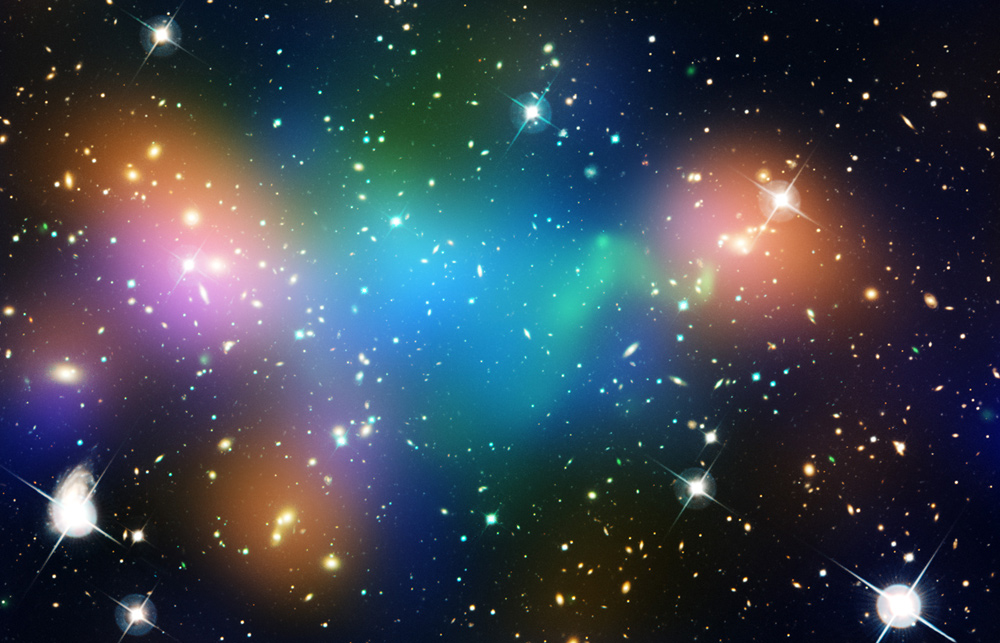Dark matter could have an electrical charge
New research into dark matter’s interaction with normal matter indicates that some dark matter could have a tiny electrical charge

Dark matter makes up roughly a quarter of the universe, with normal matter only making up five per cent and the remainder being dark energy. Image credit: NASA, ESA, CFHT, CXO, M.J. Jee (University of California, Davis), and A. Mahdavi (San Francisco State University)
A new proposal has been made describing the nature of the ever-so-elusive dark matter. In this new research, astronomers suggest that some particles of dark matter, which constitutes the majority of all matter in the universe, contain an extremely tiny electrical charge that interacts with normal matter through electromagnetic force.
“You’ve heard of electric cars and e-books, but now we are talking about electric dark matter,” says Julian Munoz of Harvard University in Cambridge, Massachusetts, United States. “However, this electric charge is on the very smallest of scales.”
This work by Munoz and his collaborator Avi Loeb of the Harvard-Smithsonian Centre for Astrophysics (CfA) in Cambridge, Massachusetts, United States, coincides with the recently announced results by the Experiment to Detect the Global EoR (Epoch of Reionisation) Signature (EDGES) collaboration. In February 2018, it was announced that scientists detected a radio signature from the first generation of stars that formed only 180 million years after the Big Bang. Laced within this research is evidence for interactions between dark matter and normal matter. While others challenged this claim from the EDGES project, Munoz and Loeb decided to look at the theoretical basis underlying it.
“We’re able to tell a fundamental physics story with our research no matter how you interpret the EDGES result,” says Loeb, who is the chair of the Harvard astronomy department. “The nature of dark matter is one of the biggest mysteries in science and we need to use any related new data to tackle it.”
This story begins with the first stars emitting intense ultraviolet (UV) light. The commonly accepted theory is that the UV light interacted with cold hydrogen atoms in the gas that permeates the space betweens stars. This also absorbed the Cosmic Microwave Background (CMB) radiation, which is the leftover radiation from the Big Bang.
This absorption should have theoretically led to a drop in intensity in the CMB during this period. The EDGES team have claimed that they detected this absorption of CMB light, however, other scientists haven’t independently verified it yet. The EDGES results have also indicated that the temperature of the hydrogen gas is about half of the expected value.

The Cosmic Microwave Background is the leftover radiation from the Big Bang. Image credit: CfA/M. Weiss
“If EDGES has detected cooler-than-expected hydrogen gas during this period, what could explain it?” says Munoz. “One possibility is that hydrogen was cooled by the dark matter.”
At the time when CMB radiation was being absorbed, the free electrons and protons associated with ordinary matter would have been moving at their slowest possible speeds. They would later be heated up by the first ever black holes’ X-ray emissions. The scattering of the charged particles is most effective at low speeds, and this implies that any interaction between dark and normal matter during this time would be strongest if the dark matter particles were charged. The interaction would cause the hydrogen gas to cool due to dark matter’s cool nature, and this would explain the unexpectedly observed signature claimed by the EDGES project.
“We are constraining the possibility that dark matter particles carry a tiny electrical charge – equal to one millionth that of an electron – through measurable signals from the cosmic dawn,” says Loeb. “Such tiny charges are impossible to observe, even with the largest particle accelerators.”
Only a small amount of dark matter that contain particles with an extremely weak electrical charge could explain the EDGES data and avoid complications with other observations. If a lot of the dark matter is charged then this would be overkill, and particles would have been deflected away from regions close to the disc of our own galaxy. This conflicts with the theory that the centre of our galaxy has an abundance of dark matter.
Scientists’ observations of the CMB state that the protons and electrons in the early universe combined to create the first neutral atoms. Only a small fraction of these charged particles, about one in a few thousand, remained free. Munoz and Loeb consider the possibility that dark matter may have acted in a similar way. The data from EDGES and similar experiments could hold the answers in regards to these few remaining charged particles, as most of the dark matter would be neutral.
“The viable parameter space for this scenario is quite constrained, but if confirmed by future observations, of course we would be learning something fundamental about the nature of dark matter, one of the biggest puzzles that we have in physics today,” says Cora Dvorkin, also of Harvard University.
Keep up to date with the latest reviews in All About Space – available every month for just £4.99. Alternatively you can subscribe here for a fraction of the price!




